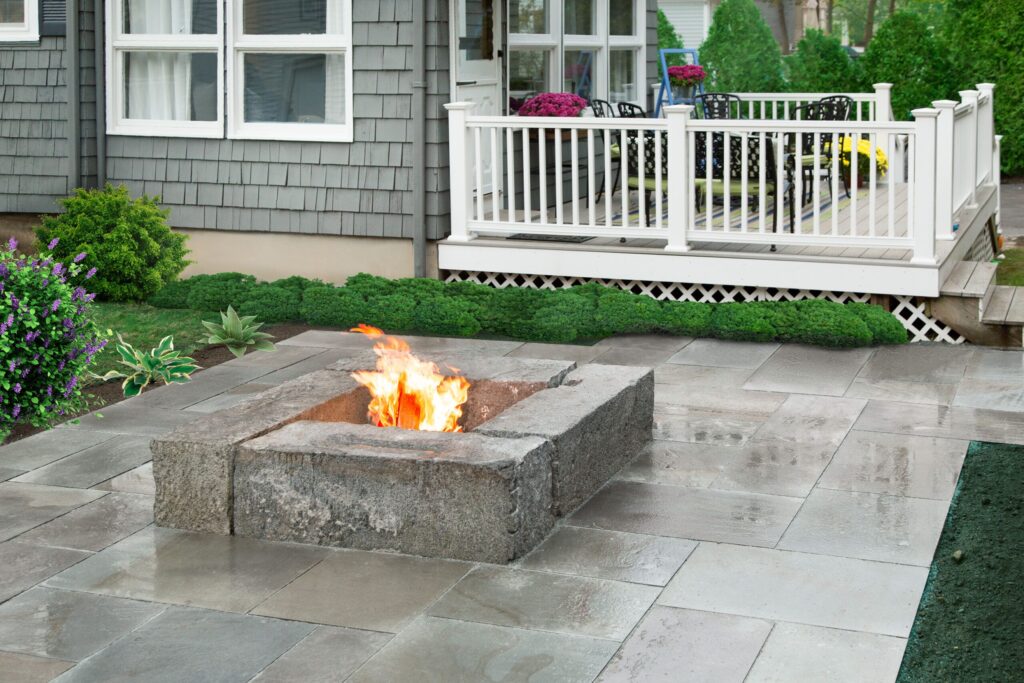What is a Patio?
A patio is an outdoor living space designed to provide an extension of the residing area and add to the overall aesthetic appeal of your home. This area is usually paved with stones, tiles, bricks, or concrete and offers a suitable place for relaxation, dining, and entertaining. It is a perfect addition to your home, especially if you love spending time outdoors.
Patios come in all shapes, sizes, and designs, and choosing the right one for your home depends on various factors such as available space, budget, and the intended purpose of the patio. Some people prefer a cozy addition to their backyard, while others may want a larger entertainment area for family and friends.
Your patio design should reflect your personal style and taste preferences. You can choose to incorporate various design elements such as outdoor furniture, planters, and lighting to create the perfect ambiance. Patios also offer an opportunity to include additional features such as outdoor kitchens, fire pits, or water fountains.
When designing your patio, it is essential to consider the materials used for the foundation, as well as the furniture and accessories. The base material of the patio should be able to withstand harsh weather conditions and heavy usage. You can choose from concrete pavers, brick, or stone, depending on your preference and the style of your home. Similarly, choose outdoor furniture that is both weather-resistant and comfortable.
In conclusion, a patio is an excellent addition to your home that can transform an underutilized backyard into a lovely outdoor living space. It provides a perfect spot for relaxing, dining, and entertaining, and the design possibilities are endless. So if you’re looking to add some style and functionality to your outdoor area, consider designing your own patio today.
Benefits of Designing Your Own Patio
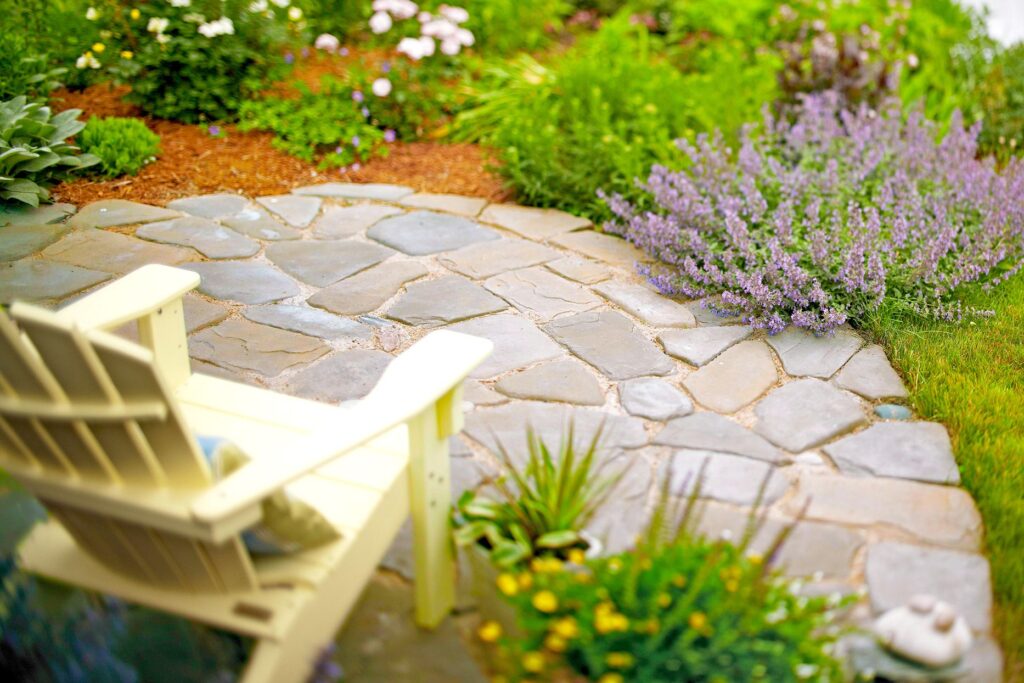
Designing your own patio can be a fulfilling and rewarding experience. Not only does it allow you to create a personalized outdoor space that reflects your personality and style, but it also offers many benefits beyond just aesthetics.
One of the most significant advantages of designing your own patio is the increased curb appeal and value it can add to your home. A well-designed patio can make your home more attractive to potential buyers and increase the overall resale value of your property.
Another benefit of designing your own patio is the added outdoor living space it provides. An outdoor living space is a great way to increase your home’s usable area without having to undertake costly and time-consuming home renovations. With a well-designed patio, you can create an outdoor oasis that is perfect for entertaining guests, relaxing, or enjoying a quiet evening alone.
Moreover, designing your own patio allows you to control every aspect of its creation, including the materials used, the layout, and the design elements incorporated. This level of control ensures that you can create a space that meets your specific needs and desires.
In addition, creating your own patio is a fun and creative process that allows you to express your personality and style. You can choose from a wide range of materials, colors, and design elements to create a personalized outdoor space that is truly unique.
Finally, designing your own patio enables you to save money on costly professional landscaping and design services. By taking on the project yourself, you can cut down on labor costs and have complete control over your budget.
In conclusion, designing your own patio offers many benefits, including increased curb appeal, added outdoor living space, creative expression, and cost savings. With so many advantages, there’s no reason not to take on this exciting and fulfilling project.
Planning Your Patio Space
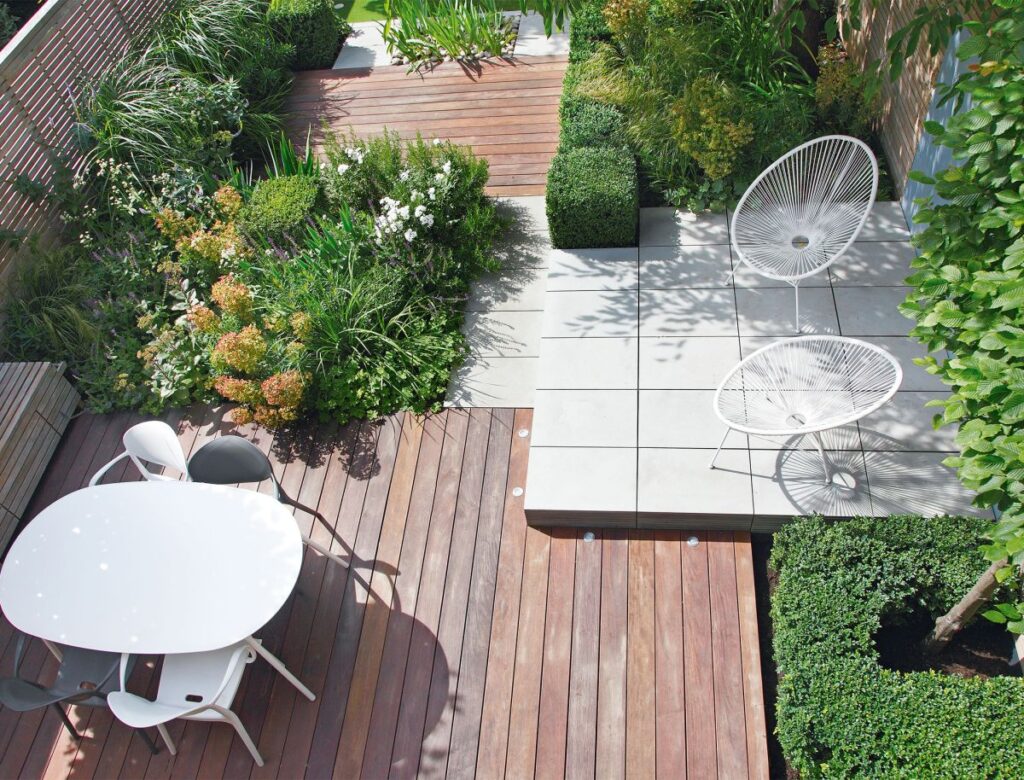
When it comes to designing your own patio, a crucial first step is planning. A well thought-out plan will save you time, money and headaches in the long run. Here are some tips to consider as you plan your patio space:
1. Determine the purpose of your patio: Are you creating a space for dining, relaxation or entertaining? The purpose of your patio space will impact the design and layout.
2. Consider the size and shape of your outdoor space: Take measurements of your outdoor area to determine the size of the patio you can create. The shape of your outdoor space will also affect the layout of your patio.
3. Choose the right materials: Consider the materials you want to use for your patio space. Common materials include concrete, pavers, stone, and wood. Selecting durable materials that can withstand various weather conditions will ensure your patio lasts longer.
4. Plan for the layout: Consider how you want to layout your patio. Will it be a single space or multiple levels? How will the furniture be arranged? Consider creating multiple gathering spots, such as a fire pit area or outdoor kitchen.
5. Consider lighting and landscaping: Outdoor lighting can transform your patio space at night. Consider adding outdoor lighting options such as string lights, spotlights, and lanterns. Also, think about adding landscaping elements such as flowers, shrubs, or trees to create a more inviting atmosphere.
6. Ensure compliance with building codes: Ensure that your patio design adheres to local building codes. This ensures safety and avoids potential legal issues that may arise later on.
7. Hire professionals if needed: If you are not confident in your ability to design and build your own patio, consider hiring professionals. This may include landscape designers, contractors, or patio installation experts.
By following these tips, you can create a functional and inviting patio space that enhances the beauty and value of your home. Planning is key to ensuring your patio is a dream outdoor oasis that fulfills all your needs and desires.
Calculate the Size and Shape
If you’re planning to design your own patio, it’s important to consider the size and shape of your outdoor space. Determining the right dimensions and layout can help you create a functional and inviting outdoor living area that meets your needs and fits your style.
To start, take measurements of your outdoor area to determine the size of the patio you can create. Measure the length and width of the space you have available, and then mark off where the edges of your patio will be. You should also consider any existing features in your outdoor space, such as trees, gardens or walkways, and think about how your patio will fit in with these elements.
Once you have determined the size of your patio, think about the shape you want it to be. Patios can be rectangular, square, circular, or irregular depending on the size and layout of your outdoor space. A rectangular or square patio is a classic choice that offers a simplified, modern look. Circular patios can create a more organic, fluid feel and complement natural surroundings like trees and gardens. If you have an irregularly shaped outdoor space, consider a custom-shaped patio that follows the lines of your property.
When deciding on the shape of your patio, consider how it will fit within the existing landscape and how it will function for your lifestyle needs. For example, a rectangular patio may be more efficient for a dining area, while a circular patio may be better suited for a fire pit or conversation area.
Taking the time to calculate the size and shape of your patio before designing can make a big difference in the final result. Whether you’re looking to entertain guests, relax with family or simply enjoy time outdoors, designing a patio that fits your needs and style can help you create the perfect outdoor living space.
Consider Your Style
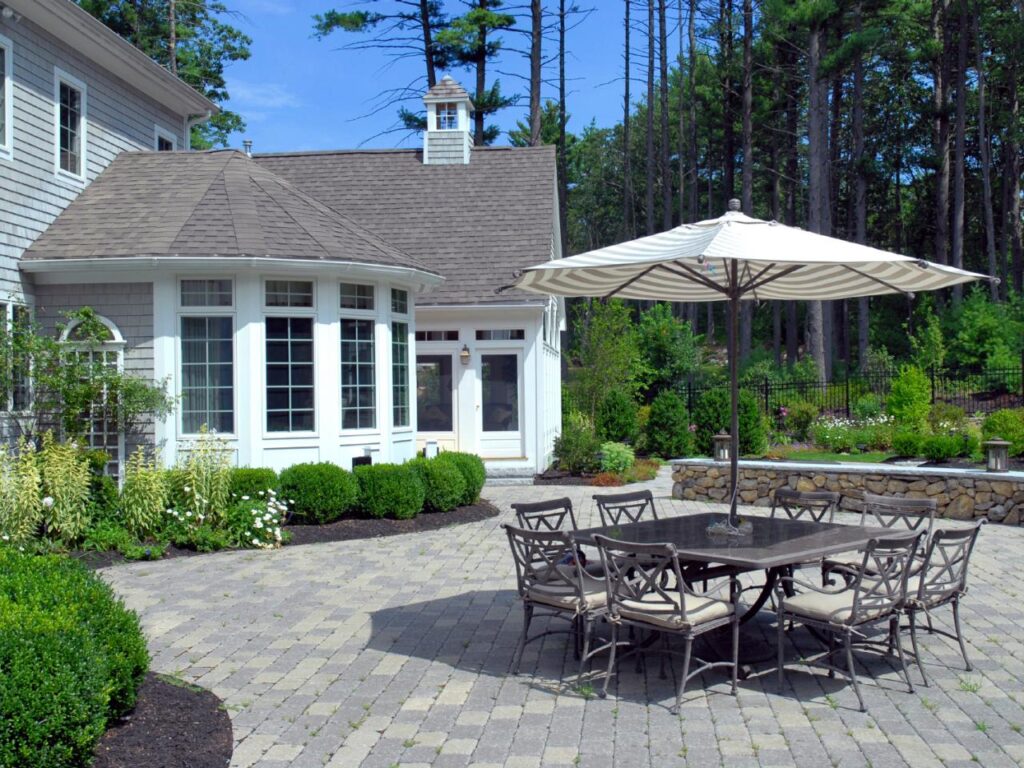
When it comes to designing your own patio, it’s important to consider your personal style. Your outdoor space should be an extension of your home and reflect your unique taste.
First, consider the style of your home’s architecture. If you have a modern, minimalist home, a sleek, streamlined patio design may be the best fit. On the other hand, if you have a traditional home with lots of character, a more ornate patio with intricate brickwork or stone detailing may be more appropriate.
Next, think about the overall vibe you want to create in your outdoor living space. Do you prefer a rustic, natural feel? Or a contemporary, polished look? Your style preferences can inform your choice of materials, colors and furnishings.
If you enjoy entertaining, your patio should be designed to accommodate guests comfortably. Consider incorporating built-in seating or a bar area for outdoor gatherings. You may also want to include features like a fire pit or outdoor kitchen for added functionality.
If you have children or pets, you’ll want to take their needs into consideration as well. A durable, low-maintenance surface like concrete pavers or stone may be the best choice for a high-traffic area. You can also add fun features like a sandbox or play area for kids.
Finally, consider your budget and timeline for the project. If you’re on a tight budget, you may need to prioritize certain elements of the patio design. You can still achieve a stylish look by incorporating budget-friendly materials like gravel or decomposed granite. And if you’re short on time, consider hiring a professional to help with the design and installation process.
In summary, designing your own patio is a fun and rewarding project that can enhance your outdoor living experience. By considering your personal style and preferences, you can create a space that’s both functional and beautiful. And with careful planning and attention to detail, you can enjoy your new patio for years to come.
Determine Your Budget
When designing your own patio, one of the most important factors to consider is your budget. Without a clear understanding of your financial limitations, it can be easy to get carried away with design plans and end up overspending. Here are some tips for determining your budget and making the most of your patio design project.
1. Establish your priorities. Determine what elements are most important to you in your patio design, whether it’s seating, lighting or a specific material like natural stone. By identifying your priorities upfront, you can focus your budget on the features that matter most to you.
2. Research costs. Look into the price range of different materials, furnishings and design elements you’re considering for your patio. This can help you determine what’s feasible within your budget constraints and give you a better understanding of the overall cost of your patio project.
3. Consult with a professional. If you’re unsure about the cost of certain elements of your patio design, consider consulting with a professional designer or contractor. They can provide insight into the cost of materials, labor and additional expenses like permits or building codes.
4. Factor in labor costs. Depending on the size and complexity of your patio project, you may need to hire a professional contractor to handle the installation. Be sure to factor in the cost of labor when determining your budget to ensure you have enough funds to cover all aspects of the project.
5. Consider long-term maintenance. While you may be focused on the upfront cost of your patio design, it’s important to also consider long-term maintenance expenses. For example, certain materials like natural stone may require more upkeep than simpler options like concrete pavers. Be sure to factor in these potential expenses when determining your overall budget.
By taking the time to determine your budget upfront, you can create a patio design plan that’s both functional and affordable. With a little planning and some flexibility, you’ll be able to create the outdoor living space of your dreams without breaking the bank.
Research Local Building Codes
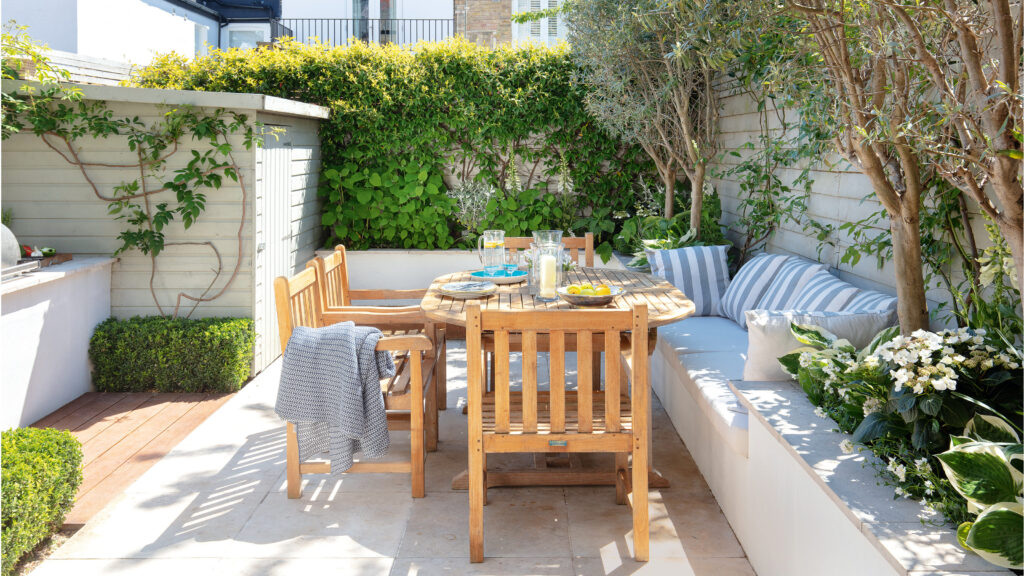
When it comes to designing your own patio, researching the local building codes should be at the top of your to-do list. Building codes are regulations put in place by local governments that address specific safety concerns related to construction and building design.
One of the main reasons why researching local building codes is so important is that it can save you time, money, and potential legal trouble. Each city and state has its own unique set of building codes and requirements, and failing to adhere to these regulations can result in fines or even the demolition of your patio.
Before you begin planning your patio design, it’s important to research the local building codes in your area. Some codes may pertain to the materials used for your patio, while others can dictate the size and placement of your patio. Failure to adhere to these codes can result in costly modifications or even legal battles down the line.
In addition to understanding the legal requirements of your location, researching local building codes can also ensure that your patio project is safe for you and your family. Building codes often take into account factors such as wind resistance, drainage, and structural stability. By adhering to these regulations, you can ensure that your patio is as safe and secure as possible.
It’s worth noting that building codes can vary depending on the type of patio you’re looking to build. For example, a multi-level patio may have different requirements than a simple backyard patio. Additionally, certain materials like fire pits or outdoor kitchens may require extra permits and regulations.
In order to research local building codes effectively, it may be helpful to consult with a professional designer or contractor. They will have experience working within the local regulations and can provide insight into what is and isn’t allowed in your area.
In conclusion, researching local building codes is an essential step in designing your own patio. By understanding the regulations and requirements in your area, you can ensure that your patio is both legal and safe for you and your family to enjoy for years to come.
Choosing Materials for Your Patio Project
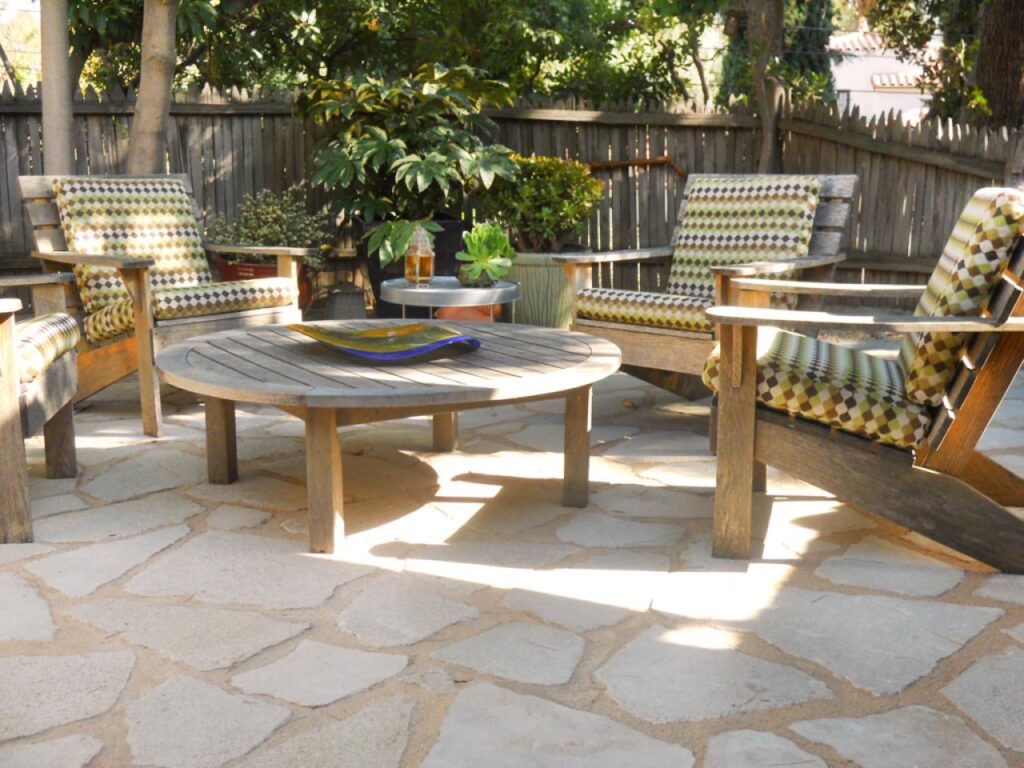
When it comes to designing your own patio, choosing the right materials is crucial to achieving a beautiful, durable, and long-lasting outdoor space. Not only should the materials you choose complement the overall aesthetic of your patio, but they should also be able to withstand the elements and the wear and tear of frequent use. Here are some tips on selecting the right materials for your patio project:
1. Consider Your Climate: The first thing to consider when selecting materials for your patio is your climate. If you live in an area with harsh weather conditions, such as extreme heat, freezing temperatures, or heavy rain, you’ll need to choose materials that can withstand these conditions. For instance, stone or concrete pavers can handle all kinds of weather and are great for high-traffic areas. On the other hand, wood and certain types of stone may not hold up as well.
2. Think About Your Maintenance Preferences: Before selecting patio materials, it’s essential to think about how much maintenance you’re willing to commit to. While some materials may need more upkeep than others, regular maintenance will help your patio last longer and maintain its appearance. For instance, natural stone requires regular sealing to prevent stains, while concrete pavers are virtually maintenance-free. Wood decks, on the other hand, require regular staining and sealing to avoid rotting and splintering.
3. Choose Materials That Fit Your Style and Budget: Another important factor to consider when selecting patio materials is the look you want to achieve and the budget you’re working with. For a rustic look, natural stone or brick pavers may be ideal, while polished concrete or stamped concrete might be better suited for a contemporary aesthetic. Keep in mind that higher-end materials like exotic woods and high-end stone can be more expensive, so make sure to choose materials that fit your budget.
4. Don’t Be Afraid to Mix and Match: Mixing and matching different materials can add depth and interest to your patio design. For instance, combining natural stone with wood or concrete pavers can create a unique look that is both practical and stylish. Don’t be afraid to experiment with different textures, colors, and patterns to create a one-of-a-kind patio that reflects your personality and style.
In conclusion, choosing the right materials is a crucial part of designing your own patio. By considering your climate, maintenance preferences, style, and budget, you can select materials that will create a beautiful, functional, and durable outdoor space that you and your family will enjoy for years to come.
Natural Stone Pavers
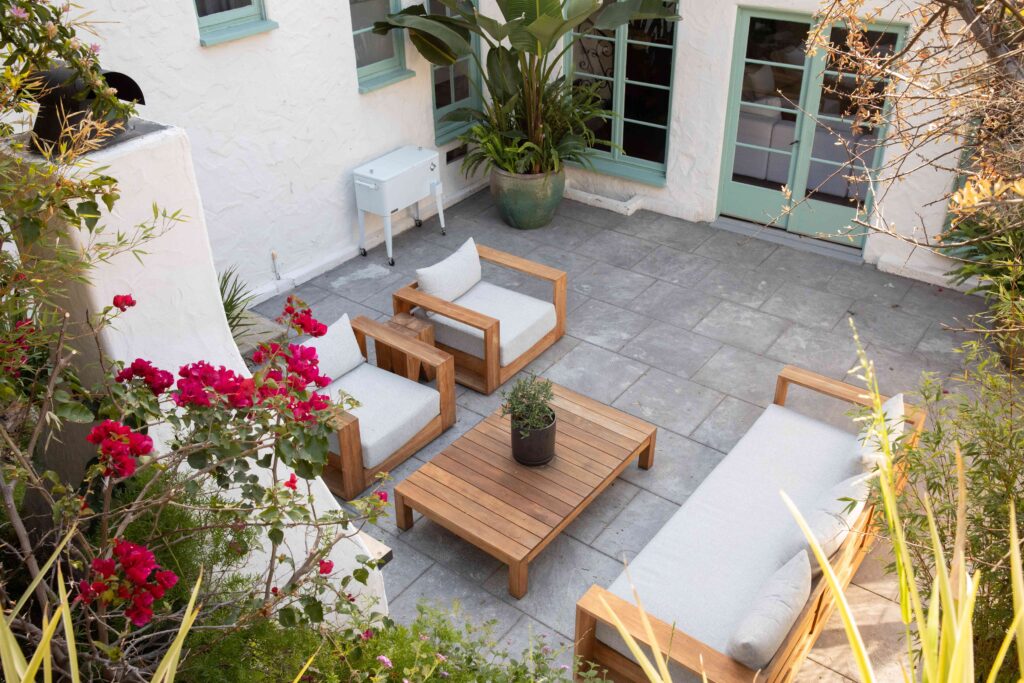
Natural stone pavers are a popular choice for creating outdoor living spaces that are both beautiful and durable. Made from natural materials like bluestone, flagstone and granite, these pavers come in a variety of shapes, sizes and colors to suit any outdoor design.
One of the most appealing characteristics of natural stone pavers is their unique and natural beauty. Each stone has its own innate texture and pattern, adding interest and variety to your patio or walkway. Whether you opt for a muted color palette or something bold and striking, natural stone pavers can add a touch of elegance to any outdoor space.
In addition to their aesthetic appeal, natural stone pavers are also incredibly durable, withstanding harsh weather conditions and heavy foot traffic. Stone pavers, unlike other materials, are not prone to fading or discoloration over time, and they don’t require much maintenance beyond occasional sealing to keep stains and wear at bay.
One thing to keep in mind when choosing natural stone pavers is that they can be costlier than other materials. This is because natural stone pavers require specialized installation and careful attention to detail in the manufacturing process. However, the investment is well worth it when you consider how long-lasting and timeless these pavers can be.
There are many different types of natural stone pavers available, each with their own unique qualities and benefits. Bluestone, for example, is a popular choice for its subtle gray and blue hues, while granite offers a more dramatic look with its speckled pattern and range of colors. Flagstone is another classic stone that offers a natural look that complements any outdoor setting.
Overall, natural stone pavers are an excellent choice for homeowners who want to create an outdoor living space that is both beautiful and practical. With their natural beauty and durability, these pavers have become a popular choice for patios, walkways and more. The prices of different types of pavers are determined according to its size
Concrete Pavers

Concrete pavers are an excellent choice for creating a durable, long-lasting patio or walkway. These paving stones are made from cement, sand, aggregates, and water, which are then molded and cured to create a strong and stable surface.
One reason concrete pavers are so popular is that they come in a variety of shapes, sizes, and colors, making it easy to find the perfect design to match your outdoor space. Whether you prefer a traditional brick look or a more modern, geometric design, concrete pavers can be used to create any style of patio or walkway.
Installation of concrete pavers is relatively easy, and can be done by either a professional or a skilled DIYer. The first step is to lay a stable base of crushed stone, which helps to prevent the pavers from shifting and settling over time. Once the base is in place, the pavers can be laid in a specific pattern using a rubber mallet to ensure they are level and secure.
Another benefit of using concrete pavers is their ability to withstand the elements. These stones are designed to resist cracking and fading, even in extreme temperatures or heavy rainfall. Additionally, pavers are easy to repair or replace if damage does occur, as only the affected stones need to be removed and replaced.
Overall, concrete pavers are an excellent choice for anyone looking to create a functional and stylish outdoor space. With their durability, versatility, and ease of installation, they are a popular option among homeowners and professional landscapers alike.
Preparing your Patio Area
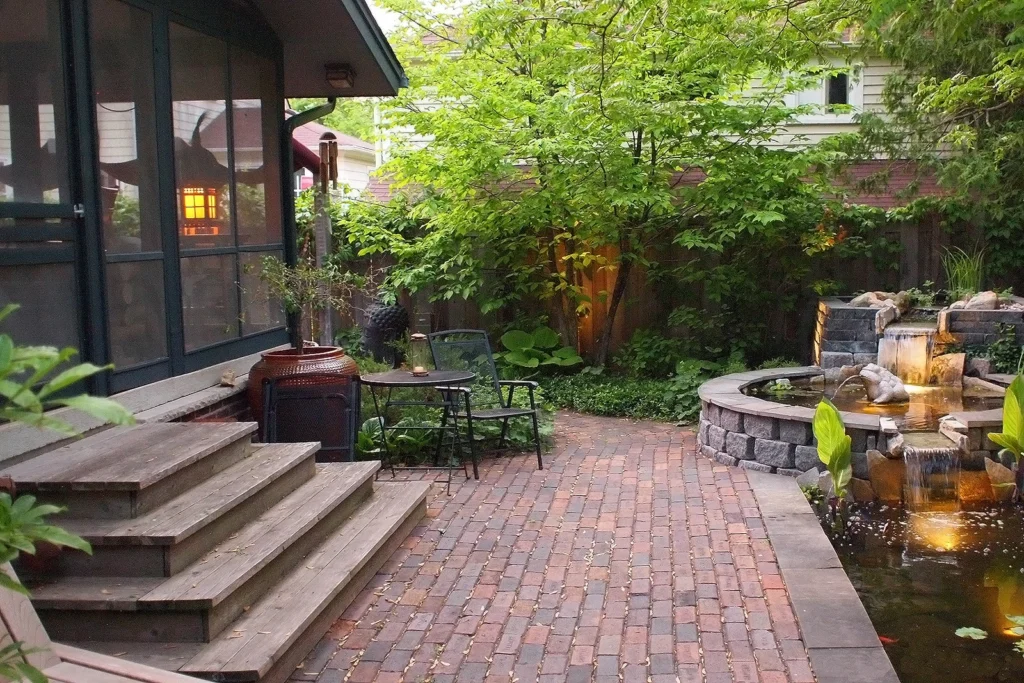
When it comes to creating your ideal outdoor living space, your patio area is the foundation upon which everything else will be built. Preparing your patio area properly before you start any patio design project is crucial to make sure that your final result is everything you want it to be.
The first step in preparing your patio area is to survey your space. Take a good look at your backyard and decide what you want your patio to accomplish. Do you want a gathering spot for friends and family, or a peaceful retreat where you can relax and unwind? Knowing what you want to get out of your patio will help determine the size, shape, and layout of the area.
Next, consider the materials you want to use for your patio. From natural stone to concrete pavers, there are a variety of materials to choose from that can add beauty, durability, and functionality to your patio area. Think about the style and aesthetic you want to create, as well as the amount of maintenance you are willing to do in order to keep your patio looking great.
Once you have your patio materials picked out, it’s time to start the preparation process. Start by clearing the area where your patio will be. This involves removing any grass, weeds, or other vegetation that may get in the way of your patio’s foundation. Then, you’ll want to compact the soil to create a sturdy base for your patio materials. You’ll also need to consider any drainage issues that may arise and plan your patio accordingly.
After this, it’s time to lay your patio materials. If you’re installing pavers, you’ll want to lay a layer of base material and then a layer of sand before laying your bricks or stones. A rubber mallet can be used to secure the pieces in place and ensure they are level. Finally, excess sand is swept over the finished surface and a polymeric jointing sand is applied to prevent movement and moisture from getting between the pavers.
No matter what your patio design ideas are, proper preparation is key to making sure your project turns out the way you want it to. By following these steps, you can create a beautiful outdoor living space that will add value and enjoyment to your home for years to come.
Clear the Area to be Paved
Clearing the area where your patio or walkway is going to be paved is an essential step to ensure the longevity and stability of your project. Before beginning to lay any materials, it’s important to remove all grass, weeds, rocks, and debris from the site.
The first step in clearing the area is to mark the boundaries of your project. This will help you stay on track and prevent you from paving outside of the designated area. You can use spray paint or string to mark the edges of your project. It’s also important to mark any areas to be avoided, such as buried utility lines or sprinkler systems.
After marking the boundaries, it’s time to start digging. You’ll want to remove all vegetation, including roots, as they can cause issues with drainage and create an uneven surface. If you’re working with a large area, a rented sod cutter or tiller can help make the job easier. For smaller areas, a shovel and rake will suffice.
Once you have cleared the site of all vegetation, it’s important to consider the ground’s drainage. Poor drainage can lead to standing water, which can cause damage to the patio or walkway over time. If your area is prone to drainage issues, you may need to add a layer of gravel or sand to help with water absorption.
After clearing and leveling the site, you’ll want to compact the soil. This will create a firm base for your materials to rest on and prevent shifting. A plate compactor or hand tamper can be used to compact the soil evenly.
Clearing the area for your patio or walkway may seem like a daunting task, but it’s necessary for the success of your project. Taking the time to properly clear and prep the site will ensure a stable and long-lasting finished product.
Prepare the Base or Foundation

Designing and building your own patio can be a rewarding and exciting experience. However, ensuring that the patio is properly constructed is crucial to its longevity and appearance. The foundation or base of the patio is a fundamental element that will determine its stability, durability, and overall aesthetic appeal.
Before beginning any patio project, it’s important to prepare the base or foundation. The base is the layer of material that will provide support to the patio and prevent shifting or settling over time. Here are some key steps to prepare the base for your patio:
1. Clear the site: Before laying the base, it’s necessary to clear the site of any vegetation or debris. This will provide a clean and level surface for the base material. Use a shovel, rake, or sod cutter to remove grass, weeds, and roots from the site.
2. Determine the size and shape: Once the site is clear, determine the size and shape of the patio. Use spray paint or string to mark the boundaries of the patio and ensure accurate measurements.
3. Excavate the soil: With the boundaries marked, it’s time to excavate the soil to create a level surface for the base. Depending on your project, you may need to excavate soil to a depth of several inches or more. Use a shovel or power excavator to remove the soil from the site.
4. Add gravel or sand: After digging out the soil, add a layer of gravel or sand to the excavated area. This layer will provide a stable base for the patio material. Use a rake to distribute the gravel or sand evenly across the site.
5. Compact the base: To ensure a solid foundation, compact the base material with a plate compactor or hand tamper. This will compress the gravel or sand, creating a firm base that will prevent the patio material from settling over time.
6. Add a layer of polymeric sand: Once the base material is compacted, add a layer of polymeric sand. Polymeric sand is a mixture of sand and special binding agents that hardens when moistened. It will fill the gaps between the patio material, preventing weed growth and water infiltration.
Properly preparing the base or foundation is essential to creating a durable and beautiful patio. By following these steps, you can ensure that your patio will provide years of enjoyment and enhance the look of your outdoor living space.
Level and Compact the Soil
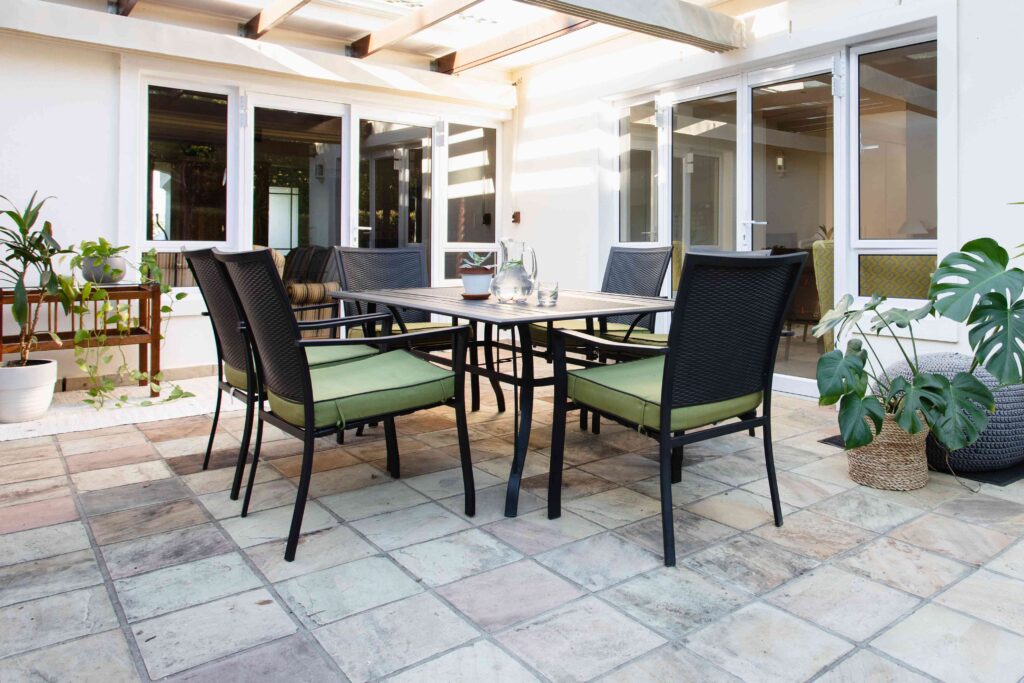
Level and compacting the soil is an important part of designing your own patio. In fact, before you start any patio project, you need to have a level and stable base. To create a stable foundation, you need to pay attention to the soil level.
Before you start leveling the soil, make sure you have cleared the site of any vegetation or debris. Use a shovel to remove any large rocks or roots on the ground. If you have a larger site, you may want to use a backhoe or tractor to clear the area.
Next, determine the size and shape of your patio and mark out the boundaries. This will help you to identify the area that needs leveling. It’s important to have a level surface to make sure the patio material sits uniformly and does not sink or shift over time. To ensure your patio sits level:
1. Use a level to check the slope of the site
2. Add or remove soil as needed to level the site
3. Use a rake to spread the soil evenly across the site
4. Use a hand tamper or plate compactor to compact the soil
Once the soil is level, you can proceed to the next step – adding a layer of gravel or sand. It’s important to make sure that the gravel or sand layer is level with the surrounding ground. An uneven layer can cause water to pool or the patio material to sink.
To make sure your patio sits level, you can use a laser level or a long spirit level to check the slopes. Make sure you check the level in multiple places across the site to ensure an even gradient.
After you’ve completed leveling and compacting the soil, it’s time to add the base layer. Adding gravel or sand will help create a stable base for the patio material. Once you’ve added the base layer, it’s important to compact it again to ensure it’s firmly packed.
In summary, leveling and compacting the soil is an important step when designing your own patio. It provides a firm foundation for the project and ensures that the patio material sits uniformly. Take the time to level your site to avoid any future complications and to have a perfect outdoor space that you can enjoy for years to come.

